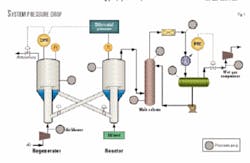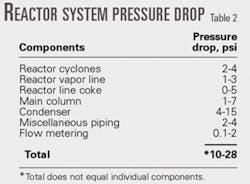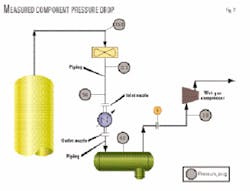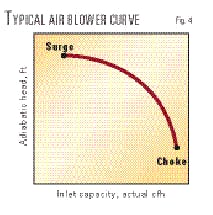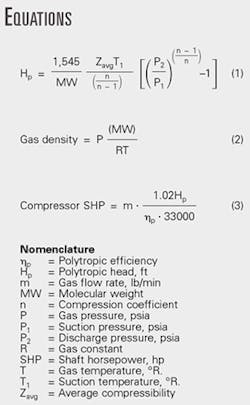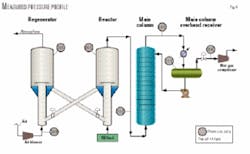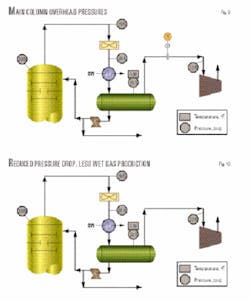Understanding how system-component pressure losses influence compressor capacity is essential for cost-effective revamps in FCC units.
Depending on the specific limitations of a particular FCC unit, capacity increases of 12-40% have been achieved without modifications to major vessels or rotating equipment. This article presents three case studies in which a manipulated pressure balance has materially reduced revamp investment by eliminating or minimizing compressor changes.
Pressure drop from the FCC air blower discharge to wet-gas compressor suction has a large influence on the performance of both compressors (Fig. 1). Because paralleling or replacing these compressors increases revamp costs significantly, one should only consider these high-cost options as a last resort.1
A lower system pressure drop often allows existing compressors to meet future requirements or permits compressor modifications at a relatively low cost.
FCC units form an integral part of modern refineries' processing sequences for upgrading crude. Expanding these units is often difficult and expensive due to constraints in major equipment capacities.
Because the FCC main fractionator, reactor, or regenerator vessel diameter, and air compressor and wet-gas compressor are linked through a pressure balance, revamp engineers should thoroughly review all practical and cost-effective pressure adjustments that impact the investment cost of a revamp. Reducing system pressure drop allows a designer to circumvent pressure limits by adjusting the major equipment design pressures.
For instance, the FCC main fractionator has an approximately 5-psi pressure drop, while a packed fractionator has a 1.0-psi pressure drop. A revamp design can recover this 4 psi and use it to debottleneck the wet-gas compressor or air blower.
Reduced main-fractionator pressure drop benefits include:
Increased suction pressure (to the wet-gas compressor) to debottleneck the compressor capacity or reduce wet-gas compressor motor requirements.
Decreased discharge pressure from the air blower to debottleneck air blower capacity.
FCC pressure balance
FCC unit operators must control the reactor-regenerator differential pressure within a relatively narrow +2 psi to –2 psi range to allow catalyst flow between the converter section vessels. Pressure drop from air blower discharge to the regenerator top and from the reactor to the wet-gas compressor inlet, however, are variables that designers must consider during a revamp.
Because most FCCs operate against either an air blower or wet-gas compressor limit, the designer should manipulate the reactor or regenerator operating pressure to minimize investment.
When the wet-gas compressor limits FCC capacity or conversion, a higher regenerator pressure increases wet-gas compressor suction pressure, thereby maximizing wet-gas compressor capacity. Conversely, when the blower is the constraint, then reactor pressure (main column overhead receiver) can decrease until the wet-gas compressor operates at 100% capacity. This increases air blower capacity.
Understanding unit pressure profile
Accurate field pressure measurements from the air blower discharge to the wet-gas compressor inlet nozzle are needed to establish individual component losses (Fig. 2). Calculations are useful tools, but measurements allow a quick determination of true losses (OGJ, May 31, 1993, p. 54).2 3
Measured values are more accurate than any calculation because they eliminate unknowns. Before one can select the most cost-effective revamp strategy, one must consider the opportunities to reduce component pressure drop and its influence on compressor capacity.
System-component pressure drop includes line losses, reactor-line coke restrictions, column internals, check valves, condensers, flow metering, and other equipment.
Some refiners, for instance, continue to measure wet-gas flow rate with an orifice plate that consumes 1 psi or more pressure drop. Although the calculation of permanent loss through an orifice plate is straightforward, actual pressure measurements upstream and downstream of the orifice eliminate unknowns, such as orifice bore size changes, that may not be documented.
System-component pressure losses can vary dramatically depending on the original equipment design and current operation.
Table 1 shows major components and range of pressure drops from the air blower to the top of the regenerator. Unnecessary pressure loss always reduces compressor capacity and raises driver energy consumption.
Because there are many potential reactor-system pressure losses, accurate pressure measurements from the reactor vessel to wet-gas compressor inlet are crucial.
For example, coke formation inside the reactor cyclones, in the reactor vapor line, and on the main column internals all generate higher component losses than calculations indicate. Coking problems are more common due to heavier and more-aromatic feeds, and the trend of higher reactor operating temperatures that produce more reactive compounds. Calculations, therefore, are simply unreliable for individual component pressure drops.
Table 2 shows typical reactor-to-wet-gas compressor system component pressure drops.
Specific equipment design and operating conditions determine actual component pressure drops. Reducing pressure drop through high-pressure-loss components can reduce overall investment.
Once pressure drops are known, one can consider specific equipment design changes. A main column overhead condenser, for example, designed with four-row tube bundles that generate seven-psi pressure drop can be modified to seven-row tube bundles that produce only two-psi drop. For a revamp, lowering the condenser pressure drop 5 psi can increase blower air rate or the amount of wet gas compressed by the existing machine by 20% or more.
Without accurate measurements and an understanding of the impact on compressor capacity, however, these opportunities may go unnoticed. Reducing component pressure loss is often used to raise compressor capacity; the amount depends on the operating point on the compressor curve.
Component pressure losses
The design and type of equipment have a major effect on pressure drop. Some equipment can be cost-effectively modified to reduce pressure drop, whereas other potential changes are expensive and yield little benefit.
For example, reactor cyclones generate approximately 1-psi pressure drop that cannot be decreased without lowering cyclone efficiency. This leads to high catalyst losses and other potential problems such as fouling in the main-column slurry circuit. In addition, new cyclones are expensive.
Conversely, most FCC main fractionators are designed with trays; pressure drops are typically 3-5 psi. Because replacing trays with packing can lower pressure drop to 1.0 psi or less, the 2-4 psi pressure drop reduction can either increase wet-gas compressor suction pressure or decrease air-blower discharge pressure.4 5
Some sources of pressure drop are due to coke formation and fouling (OGJ, Nov. 21, 1994, p. 72).6 When coke forms in the reactor vapor line or ammonium chloride salts foul the main column's top trays,7 the generated pressure drop is much higher than calculations indicate.
Low-cost modifications such as installing more insulation on the reactor vapor line or changing post-riser quench injection nozzles can reduce or eliminate coking, thus lowering pressure drop.6
Other cost-effective changes may include modifications to the process flow scheme, tower internals, heat exchanger bundles or shells, piping, control valves, replacing orifice plates with Venturi meters, eliminating fouling, etc. Because the connected process system plays a major role in determining compressor capacity, one should evaluate it as an integral unit to quantify capacity improvements.
Compressor fundamentals
Quantifying the effect of a lower system pressure drop on compressor performance begins with a review of the compressor curve and its variables. The compressor curve starts at the surge point and ends at stonewall or choke flow. When operating at the surge point, the compressor suffers from unstable flow reversals accompanied by vibration and possible damage.
At the choke or stonewall point the inlet flow volume through the compressor cannot increase. Head drops rapidly as the choke point is approached. The surge and choke points define the stable flow range.
The curve is flat near the surge point and becomes steeper as flow increases; consequently, small head changes can increase compressor capacity. As compressor operation moves to the right on the curve (toward choke) the slope increases; therefore, decreasing head has less influence on inlet flow rate.
Although the centrifugal compressor curve is similar to a pump curve, the fluid is compressible and the head generated depends on other variables. Centrifugal compressors develop a fixed head for a given inlet flow rate for typical molecular weight variations encountered in an FCC.
Because gas is compressible, its density will affect the compressor's ability to move a given mass of gas. Operating changes that increase gas density will decrease inlet volume, and those that decrease head will raise inlet volume of gas. Both higher gas density and lower head raise the mass flow rate through a compressor.
Fig. 3 shows a typical wet-gas compressor performance curve. The x-axis is volume at inlet conditions, and industry convention for the y-axis is polytropic head for a wet-gas compressor and adiabatic head for the air blower.
Operating variables that decrease head and produce a higher gas density increase a centrifugal compressor's capacity. Because the air blower compresses air from ambient conditions to the regenerator pressure, reducing regenerator pressure can increase blower capacity when it is operating on the flat part of the curve (Fig. 4).
The blower curve's slope determines the magnitude of the inlet flow rate change resulting from a given adiabatic head reduction. Blower suction conditions depend on ambient conditions; in the summer when air temperatures are higher, the gas density and molecular weight is lower. This reduces air blower capacity. Some refiners use temporary chiller units to decrease air temperature and raise air density during the summer.
Evaluating wet-gas compressor performance with reactor-system pressure drop changes requires an understanding of the practical significance of terms in Equation 1 (see equations box).
Reducing polytropic head moves the operating point to the right on the compressor curve and increases the volume of inlet gas that is compressed.
Increasing suction pressure (P1), decreasing inlet temperature (T1), and decreasing discharge pressure (P2) all lower the polytropic head. Yet one must consider the practical variability of each variable on the head term.
Because the set point on the pressure controller in the gas-recovery-unit sponge absorber determines the compressor discharge pressure, and the operating pressure generally cannot decrease without large losses of C3 to fuel gas, reducing compressor discharge pressure is generally not practical.
The reactor effluent composition, and not system pressure drop, controls the compressor molecular weight, which strongly affects compressor capacity. Increasing the wet-gas compressor inlet pressure, however, decreases head and raises gas density even though gas molecular weight decreases slightly due to increased condensation of heavier hydrocarbons.
For example, either increasing suction or decreasing discharge pressure can reduce polytropic head 1,500 ft and increase the compressor inlet-flow capacity 6% (Fig. 5).
Reducing polytropic head requires a decrease in the pressure ratio term.
For compressor discharge and suction pressures of 225 psig and 10 psig, respectively, the pressure ratio term in the head equation is 9.7 (239.7 psia/24.7 psia). Changes in suction pressure influence compressor capacity more than changes in discharge pressure.
Increasing the suction pressure 2.0 psi decreases the pressure ratio term to 9.0 (239.7 psia/26.7 psia) from 9.7. The compressor discharge pressure would have to decrease to 207.6 psig from 225 psig to produce the same head reduction.
Reducing gas plant operating pressure reduces propylene recovery and a 17.4-psi operating pressure reduction is generally not feasible. Lowering pressure drop to increase compressor suction pressure 2 psi is often possible, however.
Compressor inlet glow
Compressor curve x-axis flow is based on suction conditions. It is not expressed in standard gas flow metering units.
Wet gas is a compressible fluid; therefore, changes in compressor suction conditions that increase gas density will reduce wet gas actual volumetric flow rate. Increasing gas density moves the operating point to the left on the compressor curve. This frees up compressor capacity to meet revamp goals.
Gas density is a function of temperature, pressure, and gas molecular weight (Equation 2).
For a fixed mass flow rate and gas composition, temperature has a small effect on gas density because temperature is in absolute terms. Increasing compressor suction pressure, conversely, will increase gas density significantly and reduce the gas volume for a given mass rate.
Lower compressor suction pressures will increase the effect of pressure changes on compressor capacity. For example, increasing pressure to 20.7 psia from 17.7 psia decreases the inlet-gas flow rate 17% for the same mass flow rate. When the suction pressure is 44.7 psia, the same 3-psi change reduces gas volume only 6.7%.
Increasing gas molecular weight also raises gas density and reduces volume for a fixed mass flow rate. Reactor composition controls the gas molecular weight.
Because dry gas has a molecular weight of 21-23 and propylene-propane mixtures have a molecular weight of 43.5, changes that decrease hydrogen and dry-gas yield, and increase heavier C3 and C4 yields will increase wet-gas molecular weight and gas density. A 5% increase in gas molecular weight decreases inlet volume flow rate 5% for a fixed temperature and pressure.
Compressor capacity, driver power
Compressor power requirements also limit compressor performance at maximum turbine steam rate, speed, or motor amps. Compressor energy use is a function of mass flow, compressor polytropic head, compressor efficiency, and gear efficiency.
Equation 3 calculates compressor shaft horsepower (SHP).
Reducing polytropic head lowers the compressor shaft horsepower. In some instances, compressor suction pressure can increase enough to allow the removal of one compressor stage while still meeting design discharge pressure. This reduces compressor power consumption and may allow higher wet-gas rate without changing the driver.
Case 1: Increasing air blower capacity
Increasing FCC capacity to 48,000 b/d from 40,000 b/d raises air requirements approximately 20%. In this case, the initial engineering study recommended a new supplemental air blower with a total installed cost of approximately $3 million.
Because a higher air rate would increase pressure drop from the blower discharge to the regenerator, a higher compressor adiabatic head would have shifted the operating point to the left. The existing compressor air capacity would have decreased and the supplemental blower would have supplied more than 35% of total air rate.
Before replacing or paralleling compressors, the designer should thoroughly review the operating point on the compressor curve and system pressure drop to determine whether existing compressor air rate can increase (Fig. 6).
Either higher speed or lower blower discharge pressure is needed to increase air rate from a compressor.
In this example, the plant owner was replacing the regenerator cyclones and the regenerator vessel had a large diameter. Lowering regenerator pressure was therefore possible while incurring only a small incremental cost for the larger cyclones.
Fig. 7 shows the curve for an existing centrifugal blower. Air rate can increase 20% if discharge pressure is reduced 4.0 psi. Because a higher air rate increased pressure drop from the blower to regenerator 1.5 psi, the regenerator pressure had to be decreased 5.5 psi to lower the compressor adiabatic head enough to allow the compressor to meet the 20% increase.
Decreasing regenerator pressure 5.5 psi required a lower reactor operating pressure. In this example, the reactor hardware was modified to increase conversion while lowering dry gas yield. Wet-gas yield/volume of charge therefore decreased.
A lower reactor pressure required a decrease in the pressure drop from the reactor to wet-gas compressor suction.
Because the existing 14.5-ft ID main fractionator column internals did not meet revamp capacity, the design replaced some of the tray internals with packing. This reduced fractionator pressure drop to 3 psi from 5 psi; but an alternate solution to replace all trays with packing reduced pressure drop to 1 psi.
Other changes included replacing the wet-gas flow meter, which lowered overhead-system pressure drop an additional 1.5 psi. Additionally, heat-balance changes in the main column reduced column reflux, which further reduced pressure drop through the condensers.
Revamping the main fractionator internals from trays to structured packing and other changes permitted a 5.5-psi reduction in reactor and regenerator operating pressures.
Fig. 8 shows the unit pressure profile after the revamp. Lowering the blower discharge pressure 4 psi allowed a capacity increase of 20% because the compressor was operating on a relatively flat portion of the curve.
Case 2: Increasing
compressor suction pressure
The plant owner wanted to increase FCC unit capacity 25%, but the existing wet-gas compressor's capacity would not meet future rates without changing suction conditions.
The pre-revamp suction pressure and temperature were 15.5 psig and 130° F. Maintaining these conditions would have increased wet-gas flow rate approximately 25%, which would have required major compressor and driver modifications with an estimated total installed cost of more than $2.5 million.
Before performing extensive process calculations and equipment modeling, the designers conducted a thorough test run to measure system pressure drops.8 9 Two digital pressure gauges measured differential pressure to within ±0.03 psi.
Fig. 9 shows a measured pressure profile. Total pressure drop from the main column to the compressor inlet was 17.5 psi with 10 psi measured across the air-fan heat exchangers.
The existing air-fan bundle design used 4-tube rows with 15-hp fan motors. Pressure drop from the overhead receiver to the compressor was 3.5 psi with more than 1.5 psi across the orifice plate. The measured pressure profile identified the specific components that generated high pressure drops.
Revamping the compressor rotor and installing a larger motor would raise compressor capacity 25%. This solution was costly, however.
An alternate solution reduced system pressure drop. The piping and condenser pressure loss, and compressor performance were evaluated as a single system. Lowering air fan and orifice-plate pressure drop, and increasing fan-motor horsepower, raised the overhead receiver pressure to 23 psig and lowered the receiver temperature to 115° F., thereby lowering wet-gas production more than 35% (Fig. 10).
Air-fan bundles were changed to seven-tube rows (one pass) from four-tube rows (two pass) and 15 hp motors were changed to 35 hp to increase heat removal. These changes eliminated the modifications to the wet-gas compressor and turbine and reduced investment more than 50%.
Case 3: Increase compressor suction pressure
An 80,000-b/d FCC was being revamped to increase capacity to 100,000 b/d. An initial evaluation indicated that meeting future wet-gas rates required a new parallel wet-gas compressor and ancillary equipment. The design basis assumed the main fractionator overhead receiver operating pressure would be maintained at 12 psig.
Fig. 11 shows the proposed design with a new parallel compressor to handle a 40% more wet gas. Because most FCC wet-gas compressors have interstage condensers that control temperature rise and improve compressor efficiency, a new parallel compressor would also require significant investment in ancillary equipment.
The estimated total installed cost of a new parallel compressor system was more than $8 million.
A review of the reactor-system pressure drop showed that the main column and condensers consumed more than 17 psi. Replacing trays in the main column with packing reduced pressure drop to 1.0 psi from 6.0 psi.
The main column reflux flow was high; therefore, condensing load generated a high condenser pressure drop. During the revamp a new top pumparound was installed on the main column to reduce overhead condenser load. Less condenser load decreased pressure drop through the condensers to 8 psi from 10 psi even though the feed rate increased 25%.
Because the compressor suction pressure increased, the compressor polytropic head decreased, gas density was higher, and condensation in the overhead drum increased.
These changes reduced wet-gas production more than 35%, and eliminated the need for a new parallel compressor.
Packing the main column and installing a new top pumparound reduced investment by more than 40%. After the revamp, compressor suction pressure increased to 19 psig from 12 psig with the packed main fractionator (Fig. 12) and top pumparound. Because the compressor was operating on the flat portion of the curve, increasing the suction pressure significantly increased capacity.
References
1. Golden, S., Fulton, S., and Hanson, D., "Understanding Centrifugal Compressor Performance in a Connected Process System," Petroleum Technology Quarterly, Spring 2002.
2. Golden, S., Moore, J., and Nigg, J., "Optimize revamp performance with a logic-based approach," Hydrocarbon Processing, September 2003, pp. 75-83.
3. Golden, S., "Pushing Plant Limits: Test Runs, Plant Expectations, and Performance Confidence," World Refining, March/April 1999, pp. 75-91.
4. Hartman, E.L., Hanson, D., and Weber, B., "FCCU main fractionator revamp for CARB gasoline production," Hydrocarbon Processing, February 1998, pp. 44-49.
5. Golden, S., et. al., "FCC main fractionator revamps," Hydrocarbon Processing, March 1993.
6. Golden, S., "Revamping FCCs— Process and Reliability," Petroleum Technology Quarterly, Summer 1996, pp. 85-93.
7. Golden, S., Hanson, D, and Fulton, S., "Use better fractionation to manage gasoline sulfur concentration," Hydrocarbon Processing, February 2002, pp. 43-46.
8. Torres, G., Waintraub, S., and Hartman, E., "Crude Unit Revamp Using Radial Temperature Profiles," Petroleum Technology Quarterly, Revamps and Operations, Autumn 2003, pp. 12-14.
9. Barletta, T., "Pump cavitation caused by entrained gas," Hydrocarbon Processing, November 2003, pp. 69-72.
Based on a presentation to the Asian Refining Technology Conference 7th Annual Meeting, Singapore, Apr. 28-30, 2004.
The authors
Christopher F. Dean ([email protected]) is a refining specialist in the downstream process engineering division of Saudi Arabian Oil Co. (Saudi Aramco). He has more than 27 years' experience in the refining business, the past 8 with Saudi Aramco. His refining background includes providing technical service support with a major supplier of FCC catalysts, process engineering, process design, and operations on a variety of refinery units, with an emphasis on the FCC. Dean holds a BS in chemical engineering from West Virginia University.
Scott W. Golden ([email protected]) is a chemical engineer with Process Consulting Services Inc., Houston. His previous experience includes refinery process engineering, and distillation troubleshooting and design. Golden holds a BS in chemical engineering from the University of Maine and is a registered professional engineer in Texas.
Daryl W. Hanson ([email protected]) is a chemical engineer with Process Consulting Services Inc., Houston. His responsibilities include process and equipment design and field troubleshooting. He specializes in all phases of refinery distillation from process simulation through field inspection. Previously he was lead process specialist for Koch-Glitsch Inc. where he was involved with more than 100 column revamps including heavy oils and light-ends recovery towers. Hanson holds a BS in chemical engineering from Texas A&M University.
